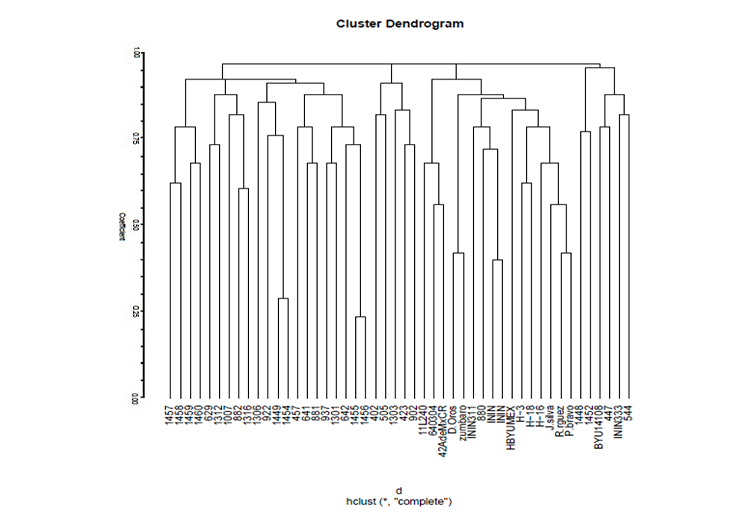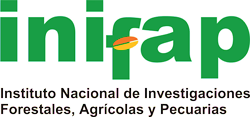Molecular characterization of wild and cultivated Chenopodium berlandieri (Chenopodiaceae) from central Mexico
DOI:
https://doi.org/10.29312/remexca.v16i6.3805Keywords:
Chenopodium berlandieri subsp. nuttalliae, Chenopodium quinua, molecular markers, SSRAbstract
The genus Chenopodium contains two species of importance in the diet of Mesoamerica and South America, namely Chenopodium quinoa Willd. (Quinoa) and Chenopodium berlandieri subsp. nuttalliae, the genetic resources of which have not been characterized despite their great nutritional potential and adaptability. In order to molecularly characterize germplasm of red chia, huauzontle (Chenopodium berlandieri subsp. nuttalliae) and quinoa (Chenopodium quinoa Willd.), we molecularly studied 48 genotypes from the Germplasm Banks of the National Institute of Nuclear Research and the Plant Genetic Resources Laboratory of Brigham Young University. To determine the genetic variability, 14 microsatellite markers (SSRs), specific for Chenopodium, were used. Genetic affinity was assessed using the Jaccard similarity coefficient and the analysis of results was performed using the UPGMA method. The results indicate that, within the studied genotypes of both species, 175 alleles were produced, ranging from 8 (KGA16, QCA88) to 16 (QCA37, QAAT74, QCA57), these being the ones that obtained the most alleles per locus. The dendrogram showed that, at a coefficient of 0.9, four main groups were formed, where groups 1 and 2 join advanced lines of quinoa and red chia, mutants of red chia and huauzontle, groups 3 and 4 joins chia and huauzontle, and group five includes all the germplasm of the Plant Genetic Resources Laboratory of BYU, mostly made up of subspecies of Chenopodium zsachei, boscianum and zinatum. It was concluded that there is a great genetic affinity between quinoa, huauzontle and red chia, which opens the possibility of inter- and intraspecific crosses for the genetic improvement of both species.
Downloads
References
Allende, C. M. J. 2017. Caracterización morfológica y molecular de accesiones de Quinua (Chenopodium quinoa Willd.) para estimar variabilidad genética. Tesis maestría en mejoramiento genético de plantas. Universidad Nacional Agraria La Molina Escuela de Posgrado. Lima, Perú. 1-90 pp.
Allende, C. L. 2014. Estudio de radiosensibilidad de pseudocereales mediante marcadores moleculares y microscopía electrónica. Tesis Licenciatura, Facultad de ciencias. Universidad Autónoma del Estado de México (UAEM). 17-40 pp.
De-Cruz, T. E.; Xingú, L. A.; García, A. J. M.; Germán, V. I. y Germán, V. G. 2010. Aplicación de técnicas moleculares en el estudio del huauzontle, cultivo prehispánico alternativo para zonas agrícolas. Contacto Nuclear ININ núm. 55. 16-21 pp.
De la Cruz, T. E.; Rubluo, I. A.; Palomino, G. H.; García, A. J. M. and Laguna, C. A. 2007. Characterization of Chenopodium germplasm selection of putative mutants and its cytogenetic study. In: Ochat, S.; Mohan, J. S. Ed. Breeding of neglected and underutilized crops species and herbs. Science Publishers. Enfield, NH, USA. 123-36 pp.
Donaire, T. G. V. 2018. Caracterización molecular de 75 accesiones de quinua (Chenopodium quínoa Willd) del departamento de puno mediante marcadores microsatélites. Tesis Facultad de ciencias. Universidad Nacional Agraria La Molina. Lima, Perú. 122 p.
Eisa, S.; Hussin, S.; Geissler, N. and Koyro, H. W. 2012. Effect of NaCl salinity on water relations, photosynthesis and chemical composition of quinoa (Chenopodium quinoa Willd.) as a potential cash crop halophyte. Australian Journal of Crop Science. 6(2):357-368.
García, A. J. M. 2017. Caracterización molecular de Chenopodium mediante SSR. Informe técnico Científico GB 209/2017. Instituto Nacional de Investigaciones Nucleares, México. 1-3 pp.
Jacobsen, S. E.; Mujica A. and Jensen, C. R. 2003. The resistance of quinoa (Chenopodium quinoa Willd.) to adverse abiotic factors. Food Rev Int. 19(1-2):99-109.
Jacobsen, S. E.; Jensen, C. R. and Liu, F. 2012. Improving crop production in the arid Mediterranean climate. Field Crop Res. 128:34-47. https://doi.org/10.1016/j.fcr.2011.12.001.
Jarvis, D. E.; Kopp, O.; Jellen, E. N.; Marllory, M. C.; Pattee, J.; Bonifacio, F. A.; Coleman, C. E.; Stevens, M. R.; Fairbanks, D. J. and Maughan, P. J. 2008. Simple sequence repeats marker development and genetic mapping in quinoa (Chenopodium quinoa Willd.). J. Genet. 87(1):39-51. https://doi.org/10.1007/s12041-008-0006-6.
Medina, F. J. 2006. Composición nutricional de la quinua. http://xa.yimg.com/kq/groups/21260884/1421089015/name/Composici%C3%B3n+Nutricional+de+la+Quinua.doc.
Morales, A. y Zurita, S. A. 2009. La quinoa como fuente de genes de resistencia a estrés por sequía. Centro Estudios Avanzados en Zonas Áridas, CEAZA. La Serena, Universidad Andrés Bello, Santiago, Chile. 1-8 pp.
Mason, S. L.; Stevens, M. R.; Jellen, E. N.; Bonifacio, F. A.; Fairbanks, D. J.; Coleman C. E.; McCarty, R. R.; Rasmussen, A. G. and Maughan, P. J. 2005. Development and use of microsatellite markers for germplasm characterization in quinoa (Chenopodium quinoa Willd.). Crop Sci. 45(4):1618-1630. https://doi.org/10.2135/cropsci2004.0295.
Maughan, P. J.; Jellen E. R.; Stevens, M. R.; Coleman, C.E.; Ricks, M.; Mason, S. L.; Jarvis, D. E. and Gardunia, B. and Fairbanks, D. J. 2013. Manual. DNA Microprep extraction. Plant genetic resources laboratory of Brigham young university (BYU). Provo, Utah, USA. 1-3 pp.
Maughan, P. J.; Jarvis, D. E.; Cruz-Torres, E.; Jaggi, K. E.; Warner, H. C.; Marcheschi, A. K.; Gomez-Pando, L.; Fuentes, F. ; Mayta-Anko, M. E.; Curti, R.; Rey, E.; Tester, M. and Jellen, E. N. 2024. North American pitseed goosefoot (Chenopodium berlandieri) is a genetic resource to improve Andean quinoa (C. quinoa). Scientific reports. 14:1-13. https://doi.org/10.1038/s41598-024-63106-8.
Nolasco, O. C.; Cruz, W.; Santa-Cruz, C. and Gutiérrez, A. 2013. Evaluation of the DNA polymorphism of six varieties of Chenopodium quinoa Willd, using AFLP. The Biologist. 11(2):277-286.
Ramírez, V. M. L.; Espitia, R. E.; Carballo, C. A.; Zepeda, B. R.; Vaquera, H. H. and Córdova T. L. 2011. Fertilization and plant density in varieties of amaranth (Amaranthus hypochondriacus L.). Revista Mexicana de Ciencias Agrícolas. 2(6):855-866. http://www.redalyc.org/articulo.oa?id=263121473005.
Xingú, L. A. 2010. Caracterización del germoplasma de Huauzontle (Chenopodium berlandieri subsp. nuttalliae) en el Estado de México mediante técnicas moleculares (SSR), Tesis de Maestría, Universidad Autónoma del Estado de México. 9-16 pp.
Xingú-López, A.; Balbuena-Melgarejo, A.; Laguna-Cerda, A. L. G.; Iglesias-Andréu, L. G.; Olivares-Cruz, V. y Cruz-Torres. E. 2018. Caracterización de huauzontle (Chenopodium berlandieri spp. nuttalliae) del Estado de México mediante microsatélites. Ciencia y Tecnol. Agrop. México. 2(6):9-16.
Yasui Y.; Hirakawa, H.; Oikawa, T.; Toyoshima, M.; Matsuzaki, C.; Ueno, M.; Mizuno, N.; Nagatoshi, Y.; Imamura, T.; Miyago, M.; Tanaka, K.; Mise, K.; Tanaka, T.; Mizukoshi, H.; Mori, M. and Fujita, Y. 2016. Draft genome sequence of an inbred line of Chenopodium quinoa, an allotetraploid crop with great environmental adaptability and outstanding nutritional properties. DNA Res. 23(6):535-546. https://doi.org/10.1093/dnares/dsw037.

Published
How to Cite
Issue
Section
License
Copyright (c) 2025 Revista Mexicana de Ciencias Agrícolas

This work is licensed under a Creative Commons Attribution-NonCommercial 4.0 International License.
The authors who publish in Revista Mexicana de Ciencias Agrícolas accept the following conditions:
In accordance with copyright laws, Revista Mexicana de Ciencias Agrícolas recognizes and respects the authors’ moral right and ownership of property rights which will be transferred to the journal for dissemination in open access. Invariably, all the authors have to sign a letter of transfer of property rights and of originality of the article to Instituto Nacional de Investigaciones Forestales, Agrícolas y Pecuarias (INIFAP) [National Institute of Forestry, Agricultural and Livestock Research]. The author(s) must pay a fee for the reception of articles before proceeding to editorial review.
All the texts published by Revista Mexicana de Ciencias Agrícolas —with no exception— are distributed under a Creative Commons License Attribution-NonCommercial 4.0 International (CC BY-NC 4.0), which allows third parties to use the publication as long as the work’s authorship and its first publication in this journal are mentioned.
The author(s) can enter into independent and additional contractual agreements for the nonexclusive distribution of the version of the article published in Revista Mexicana de Ciencias Agrícolas (for example include it into an institutional repository or publish it in a book) as long as it is clearly and explicitly indicated that the work was published for the first time in Revista Mexicana de Ciencias Agrícolas.
For all the above, the authors shall send the Letter-transfer of Property Rights for the first publication duly filled in and signed by the author(s). This form must be sent as a PDF file to: revista_atm@yahoo.com.mx; cienciasagricola@inifap.gob.mx; remexca2017@gmail.
This work is licensed under a Creative Commons Attribution-Noncommercial 4.0 International license.


